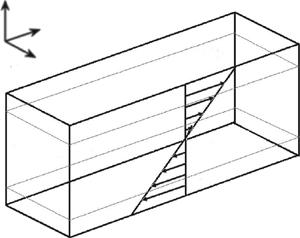Article contents
Spectral energetics of a quasilinear approximation in uniform shear turbulence
Published online by Cambridge University Press: 06 October 2020
Abstract

The spectral energetics of a quasilinear (QL) model is studied in uniform shear turbulence. For the QL approximation, the velocity is decomposed into a mean averaged in the streamwise direction and the remaining fluctuation. The equations for the mean are fully considered, while the equations for the fluctuation are linearised around the mean. The QL model exhibits an energy cascade in the spanwise direction, but this is mediated by highly anisotropic small-scale motions unlike that in direct numerical simulation mediated by isotropic motions. In the streamwise direction the energy cascade is shown to be completely inhibited in the QL model, resulting in highly elevated spectral energy intensity residing only at the streamwise integral length scales. It is also found that the streamwise wavenumber spectra of turbulent transport, obtained with the classical Reynolds decomposition, statistically characterizes the instability of the linearised fluctuation equations. Further supporting evidence of this claim is presented by carrying out a numerical experiment, in which the QL model with a single streamwise Fourier mode is found to generate the strongest turbulence for  $L_x/L_z=1\sim 3$, consistent with previous findings (
$L_x/L_z=1\sim 3$, consistent with previous findings ( $L_x$ and
$L_x$ and  $L_z$ are the streamwise and spanwise computational domains, respectively). Finally, the QL model is shown to completely ignore the role of slow pressure in the fluctuations, resulting in a significant damage of pressure-strain transport at all length scales. This explains the anisotropic turbulence of the QL model throughout the entire wavenumber space as well as the inhibited nonlinear regeneration of streamwise vortices in the self-sustaining process.
$L_z$ are the streamwise and spanwise computational domains, respectively). Finally, the QL model is shown to completely ignore the role of slow pressure in the fluctuations, resulting in a significant damage of pressure-strain transport at all length scales. This explains the anisotropic turbulence of the QL model throughout the entire wavenumber space as well as the inhibited nonlinear regeneration of streamwise vortices in the self-sustaining process.
JFM classification
Information
- Type
- JFM Papers
- Information
- Copyright
- © The Author(s), 2020. Published by Cambridge University Press
References
REFERENCES
- 9
- Cited by


